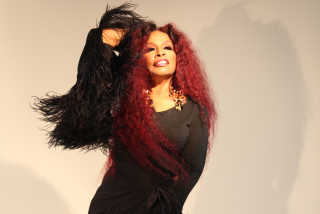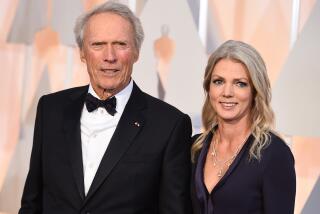The Few, the Proud, the Rockettes
It’s 11 in the morning in early November, and there are Rockettes in the gymnasium of the Hollywood United Methodist Church, marshaling their forces just as industriously as troops preparing for war games. Of course, they march to a different drummer--the one next to the pianist who plays the “Parade of the Wooden Soldiers”--and for a different kind of display--the first “Radio City Christmas Spectacular” to be staged on the West Coast. But there is a military-like precision in the air that any soldier would recognize.
Arms are pinned severely to sides as stiff, bite-sized steps are taken in never-ending columns; heads have to be held at the correct angle, so all hat feathers will be parallel; and the habit of leading with one shoulder when changing direction must, must be broken. Not to mention the fact that each step, each gesture, each trademark kick must mirror those of all other Rockettes--not “close enough for rock ‘n’ roll,” but as identical as you can get without using actual cloning technology.
It might be true, as has been said with a straight face, that you don’t have to be a Rockette scientist to do precision dancing. But there is a certain amount of mathematical aptitude involved, and it takes a rare talent to combine that with precise technique and the requisite pizazz. Each Rockette lives an onstage life controlled by numbers taped to the stage edge and two thin lines (appropriately colored red and green) that bisect it. It’s a bit like learning the austere routine of the changing of the guard, except that Rockettes also have to sparkle. And pay attention to dynamics, rhythm and style. Details, details--all to make sure that you, the ticket-buying public, can have yourself a merry little kick line.
On Wednesday, these Rockettes, a combination of veterans and new recruits, will bring Radio City Music Hall’s 65-year-old tradition of precision dancing to the Universal Amphitheatre. This will be the fifth CONY show--that’s Christmas Outside New York for those who don’t know that the holiday spectacular genre revolves around Radio City Music Hall as the Earth orbits the sun. The franchising operation began in 1994, when someone must have realized that precision Irish dancers weren’t the only act that could successfully be taken on the road. That year, a “Radio City Christmas Spectacular” opened in Branson, Mo., and since then, the movement has spread to Myrtle Beach, S.C.; Detroit; Chicago; and now Los Angeles.
CONY shows are designed along the lines of the mother show in New York--in addition to the Rockettes, there are ice skaters, a dancing and singing chorus, Santa, little people (as, what else? elves) and a whole stable full of real animals. About half of the numbers are essentially the same as New York’s: in addition to “Parade of the Wooden Soldiers” (which was designed by a young Vincente Minnelli in 1933), there is “The Living Nativity,” “Carol of the Bells,” an all-bear “Nutcracker” and “Christmas in New York.” It was decided to export snowy scenes and urban bustle, rather than create, for instance, an indigenous “Christmas in L.A.”
“What would that be--people playing tennis?” says Angelino David Nash, who has produced the spectacular in New York, Branson and Chicago before his current Los Angeles stint. “You have to put a sign up to know it’s Christmas here. In this show, we have people throwing snowballs, shopping on Fifth Avenue, skating at Rockefeller Center--now that’s Christmas.”
*
On this particular day, camera crews have come to preview the latest inheritors of kick-line culture. There are 18 of them (Radio City has 36), and they come from across the country, having trained in tap, ballet, jazz and musical theater (Rockettes also sing). They are all, as required, between 5-foot-5 1/2 and 5-foot-9 and range in age from 18 to thirtysomething.
Choreographer Linda Haberman knows what the press has come to see, and each Rockette, without being asked, has worn beige tights with a rehearsal leotard to heighten the effect of their nascent synchronization. “Wooden Soldiers” maneuvers are halted momentarily to show a section of “Christmas in New York” that culminates in a kick line.
“OK, ladies,” Haberman shouts, “Let’s take it from the sit-down drill to the end.”
The sit-down drill turns out to be a series of seated, Busby Berkeley-type cheesecake poses, a campy reminder of the fact that the Rockette tradition evolved out of ‘20s showgirl routines and pulchritudinous Hollywood. Then the dancers stand and move forward with a series of jazzy steps that build toward their power moment. As the music starts to slow down and get louder, they fall into a straight line and do some teaser toe-pointing and low kicks, shifting from side to side, before finally linking up, shoulder to shoulder, and bobbing into rapid high kicks on every beat--16 of them.
Rockette lore says that applause invariably starts between the eighth and 12th kick. And a Rockette secret is that, although they appear to grab each other around the waist chummily, each dancer barely touches the next, to avoid affecting individual centers of balance.
Even with a small and somewhat preoccupied audience, this kick line has raised the energy level in the room perceptibly. When the last ta-da is sounded, there is an unaccountable afterglow, as if something brave and wonderful just occurred--a kind of festive solidarity. It’s what esteemed dance critic Edwin Denby, reviewing Rockettes in 1944, called “a very pleasant moment of contentment all around,” because “everyone can see that they accomplish what they set out to do to perfection.”
*
What Rockettes set out to do, of course, is precision dancing, which should by all rights be out of style in a country where the assembly line is a synonym for monotony, and individuality in art is so highly prized. How do these dancers feel about embracing a cookie-cutter aesthetic in a world where everyone wants to stand out?
“You don’t feel like doing that when you’re a Rockette--that’s not what it’s about,” says Redlands native Ann Miller on her hour lunch break. At 26, Miller has donned Rockette high heels for three previous CONY shows. “The whole theme is that everyone looks exactly alike, and I guess that’s part of the art--taking 18 women who are very different, who have their own look and size and smile, and making them into one unit. You don’t want to project yourself; you want to be part of the whole and make the whole shine as much as you can. That’s what it’s about.”
Which might explain why there are virtually no ex-Rockettes who have become superstars. When friends and relatives come to the show, they are armed with directions for locating their Rockette in the line of mirror images--Miller is eighth from the left, for instance. But at least the job has wide recognizability in other ways.
“My friends who aren’t in the theater community have no response when I get cast in other shows,” says Sally Wong (second from the right), a 27-year-old Rockette in her third year. “But everybody knows who the Radio City Rockettes are, and they get excited.”
Unlike Rockettes of old, who were onstage year-round at Radio City Music Hall, these dancers don’t do four or five shows a day, year-round. Instead, today’s dancers work on short-term contracts for the Christmas spectacular (the only in-house show left at Radio City), and perhaps other assignments when Rockettes are hired for awards shows, conventions and the Macy’s Thanksgiving Day parade. (There is now a rotating pool of more than 200 Rockettes.) So dancers have plenty of time to take jobs that offer more creative range. Miller, a dance graduate of UC Irvine, has had several roles in musicals, as has Wong.
For 20-year-old newcomer Tara Metzger, third from the left, being a Rockette is enough for now. In fact, having received her early dance training on Long Island from two ex-Rockettes, she says she was driven to join the line. “I like being part of a team--one of everyone,” she says. “It’s a nice feeling to have all the girls around you and all of you doing the same thing to bring off such a powerful performance. The audience is watching all of us almost like the Rockettes are one girl.”
This uniformity, unfortunately, had one major drawback for many years--the “one girl” idea meant “one white girl.” The line was not integrated until the last half of the ‘80s, and there are still relatively few Rockettes of color. Wong, who is from Redondo Beach, didn’t know the history when she first auditioned. “The Rockette line I saw as a kid was all one color,” she says, “but the audition notice said something like, ‘all ethnicities welcome,’ so I assumed it was possible.”
Having performed for two years in the Branson show, Wong has become aware of how her presence in the Rockettes is a hopeful sign for minorities. “I didn’t used to feel I was representing ‘all Asian Americans’ when I dance in the Rockettes, but the more people I met who said, ‘Gosh, you’ve opened the door,’ the more I’ve started to accept that. Usually it’s the parents who come up after the show and say they never knew their child might be able to do this.”
If, of course, their child possesses that magical quality of being able to stay in sync while singing, dancing and manipulating props.
“You hit yourself in the head once with that candy cane,” says Miller with a laugh, “and you remember not to do it again.”
Metzger finds that her ex-Rockette teachers prepared her well for using her candy cane like a weapon, as the Rockettes do in a number called “The Holiday Season.” She explains that as a student, her teachers brought in a soldier to teach a real rifle drill for one of their precision dance concerts.
The military connection surfaces again when Miller talks about the first time her brother saw the show. “He was in the Army, stationed in Germany, when I first started, but when he finally got to see it, he was really impressed with ‘Wooden Soldiers.’ He said we could do serious battle with the guys at West Point.”
*
If the Rockettes are like an entertainment army, choreographer Haberman is strategic command, and veteran Rockette Rebecca Downing often plays the role of the drill sergeant, as she does in an afternoon “clean-up” session for “Wooden Soldiers.” Constantly consulting a diagram in her hand, she glances back and forth between its arcane markings and the line of women standing at attention and shifting an inch this way and that in relation to the taped numbers that dictate their positions.
For half an hour, the conversation has gone something like this: “Nicky, you’re just outside of 2. Kelly, are you toeing or heeling 4? Helena, you’re right on 5 and a half--does that look right?” Numbers are recorded and adjusted--why is that gap there? It turns out that someone has narrower shoulders than the rest. In the corner, making her own notes, Anne Mason has perhaps the most unnerving assignment of all--she’s the “swing,” or understudy, who has to step into any position in the line if injuries or influenza necessitates. She looks worried.
When the dancers finally start to move, directions are often given in code, a kind of Rockette-speak. “Digging a hole,” is what the anchor person in a pivot does in order to stay stationary; “guiding” right or left refers to the process of lining yourself up with the chest of the dancer one over from you to keep the line uniform (no one knows why this works better than watching the dancer next to you); “covering off to your downstage girl” means you stand directly behind the dancer in front of you; and “shifting out” is what you simply never want to do--break Rockette protocol by losing your place in line.
Since Radio City Music Hall opened in 1933, the idea of the Rockettes has basically been the same--the wooden soldiers, for instance, still do their amazing domino-like fall--but changing styles and advances in technique have meant that today’s Rockettes can do more. Haberman, who works with all of the Christmas spectaculars outside New York, is a former Broadway dancer whose numbers show her influences from jazz greats Jack Cole and Bob Fosse.
“If there’s anything I’ve contributed, it’s making the Rockettes more sensual and less robotic, in terms of the style of my movement,” she says. “I don’t want them to seem cute all the time. I want them to be strong as well as sexy, and I think that’s possible to a degree. You just have to be creative in finding a vocabulary that lends itself to being cleaned up for precision dance.”
In rehearsal for “Bizzazz,” a few days later, Rockettes are indeed striking sensuously angled poses and swiveling hips more than their earlier counterparts. But there is a no-nonsense briskness that keeps the mood light. As late as 1978, New York critic Anna Kisselgoff was saying that the secret of the Rockettes was their their lack of sex appeal, their holdover 1930s innocence.
The historical reasons for the Rockettes’ upbeat and slightly mechanical personalities have not been documented with any rigor--Rockette-ology is evidently still in its infancy. Some dance writers have speculated that precision dancing has precedents in unison tribal rituals--even citing the high kick as a symbol of fertility, as if practices in village rituals were somehow directly transferred to kick lines. But it’s in British music halls that more immediate Rockette ancestors are found.
The Tiller Girls, a proto-Rockette troupe formed at the end of the 19th century by a British businessman, was something of a Victorian backlash to more flirtatious, sex-for-sale show dancing. Moving in strict patterns, Tiller Girls were called “bird-like” when they performed in New York’s Ziegfeld Follies in 1925. At that time, Russell Markert, an enterprising dance director for a St. Louis theater, saw them and immediately formed his own version, first called the 16 Missouri Rockets. In 1932, another theater director (and ex-Marine sergeant), Samuel L. Rothafel, brought the troupe to his Roxy Theatre in New York, renamed them the Roxyettes, and finally the Rockettes when they moved into the new Radio City Music Hall.
There were big plans for the Rockettes in those days. In 1933, they were on the opening Music Hall bill with Ray Bolger, Martha Graham and German expressionist dancer Harold Kreutzberg. Graham might have had further involvement with the troupe had not the stage show format been converted soon to accommodate movies. After that, Rockette numbers were choreographed with themes that matched each new movie (they prayed for a long run) and shared a bill with other acts and the corps de ballet, which was disbanded in 1974.
Although some Rockette numbers were undoubtedly forgettable--and in a few cases, regrettable (a “chain gang” dance linked each dancer by ankle irons)--there were also events that pointed to the troupe’s excellence. In 1937, the Rockettes beat out dancers from the Paris Opera and Ballet Russe de Monte Carlo to win the grand prize at the Paris International Exposition.
*
Nowadays, the Rockettes have settled into their niche as a national institution bathed in kitsch and ruled by the god of exactitude. Back in the rehearsal room at the Methodist church, for instance, they go over once again just where to put their hands on their giant candy canes and how close to Santa they can stand.
“Santa will be toeing that green line,” Haberman is saying. “Just remember to keep in control of your canes, ladies; don’t let them get the best of you.”
Santa romps freely among the regulated Rockettes, as they strut and sing about how he’s a guy who can really get down. More precisely: “Santa knows what he’s got, and what he’s got is bizzazz”--presumably an even hipper version of the traditional pizazz.
But you can only take the frisky performance of Christmas music so far. Rockettes will be dressed as characters in the final, 12-minute nativity scene of the “Radio City Christmas Spectacular,” but they won’t be kicking up their heels to the Hallelujah Chorus. Choreographer Haberman--having placed the Rockettes in so many well organized columns over and over--knows where to draw the line.
*
Radio City Christmas Spectacular, Universal Amphitheatre, Universal City, $19.50-$59.50. Forty performances Wednesday through Dec. 29, except Dec. 14 and Christmas Day. (213) 252-TIXS.
More to Read
The biggest entertainment stories
Get our big stories about Hollywood, film, television, music, arts, culture and more right in your inbox as soon as they publish.
You may occasionally receive promotional content from the Los Angeles Times.






